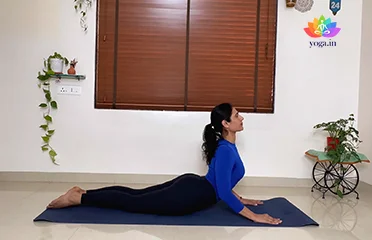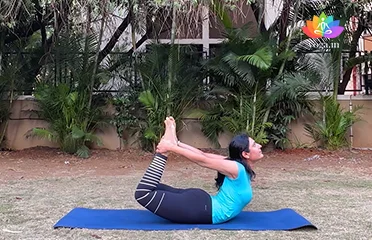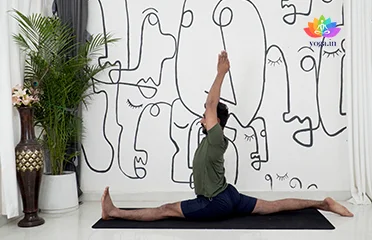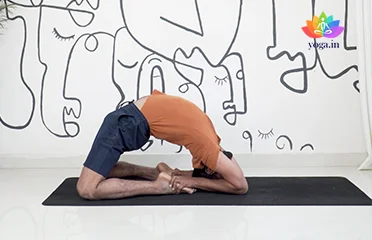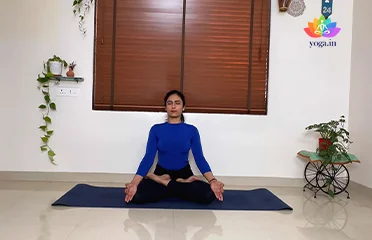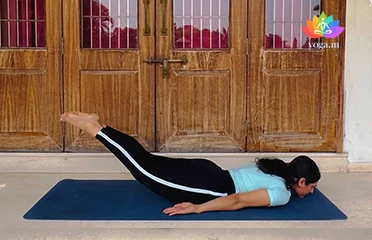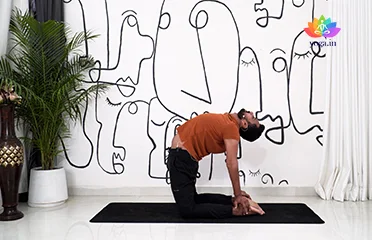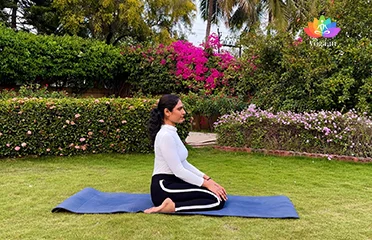Bhujangasana (Cobra Pose)
भुजंगासन / Cobra Pose
The Sanskrit name is derived from Bhujanga (भुजंगा) meaning cobra [�K]
Dhanurasana (Bow Pose)
धनुरासन / Bow Pose
The Sanskrit name is derived from Dhanur (धनुर) means bow and Asana [�K]
Hanumanasana (Monkey Pose)
हनुमानासन / Monkey Pose
The Sanskrit name is derived from the Hindu God -Hanuman (हनुमान) [�K]
Kapotasana (Pigeon Pose)
कपोटासन / Pigeon Pose
The Sanskrit name is derived from Kapota (कपोटा) meaning pigeon or [�K]
Padmasana (Lotus Pose)
पद्मासन / Lotus Pose
The Sanskrit name is derived from Padma (पद्मा) meaning lotus and [�K]
Shalabhasana (Locust Pose)
सलभासन / Locust Pose
The Sanskrit name is derived from Shalabha (शलभा) meaning locust and [�K]
Ushtrasana (Camel Pose)
उष्ट्रासनI / Camel Pose
The Sanskrit name is derived from Ushtra (उष्ट्रासनI) meaning [�K]
Virasana (Hero Pose)
वीरासन / Hero Pose
The Sanskrit name is derived from Vira (वीरा) meaning hero or a warrior [�K]
Yoga for Coccyx Pain – Gentle Movement and Support
Yoga can be a valuable tool for managing coccyx pain, also known as tailbone pain. However, it’s crucial to approach it with caution and prioritize seeking guidance from a healthcare professional or qualified yoga therapist familiar with coccydynia (tailbone pain).
Understanding Coccyx Pain
The coccyx, the small bone at the bottom of the spine, can become inflamed or bruised due to various reasons like falls, childbirth, or repetitive strain. This can lead to pain in the tailbone area, especially when sitting or standing for extended periods.
Benefits of Yoga for Coccyx Pain
While yoga doesn’t cure coccyx pain, it can offer several benefits for managing symptoms:
- Improved Flexibility: Gentle yoga movements can help improve flexibility in the hips and lower back, potentially reducing tension that may contribute to coccyx pain.
- Pain Management: Yoga practices can promote relaxation and stress reduction, which may indirectly help manage pain perception.
- Strengthening Core: Certain yoga poses can strengthen the core muscles, which can improve posture and support the spine, potentially reducing pressure on the coccyx.
- Enhanced Body Awareness: Yoga encourages a mindful approach to movement, allowing you to identify areas of discomfort and modify practices accordingly.
Safe Yoga Practices for Coccyx Pain
Here are some general guidelines for incorporating yoga into your routine when managing coccyx pain:
- Focus on Supported Postures: Prioritize yoga poses that allow you to sit or lie down with support for your coccyx. Use props like bolsters, pillows, or rolled-up towels for added comfort.
- Avoid High-Impact Movements: Avoid poses that involve jumping, jarring movements, or deep twisting, which can aggravate coccyx pain.
- Modify as Needed: Don’t hesitate to modify yoga poses to suit your individual needs and comfort level. Listen to your body and stop any pose that causes pain.
- Focus on Breathwork: Pay attention to your breath throughout your practice. Slow and steady breathing can promote relaxation and enhance focus.
Additional Tips –
- Warm Up: Before starting your yoga practice, perform gentle warm-up exercises to prepare your body for movement. Focus on gentle stretches for the hips, lower back, and hamstrings.
- Cool Down: After your practice, take time to cool down with gentle stretches and relaxation techniques.
- Consistency is Key: Regular yoga practice, even for short periods, can be more beneficial than infrequent long sessions.
- Listen to Your Body: Always pay attention to your body’s signals. Stop if you experience any pain or discomfort and consult a healthcare professional if needed.
By incorporating these guidelines and seeking guidance from a qualified professional, yoga can become a safe and valuable tool for managing coccyx pain. Remember, prioritize professional medical advice and prioritize your well-being.


